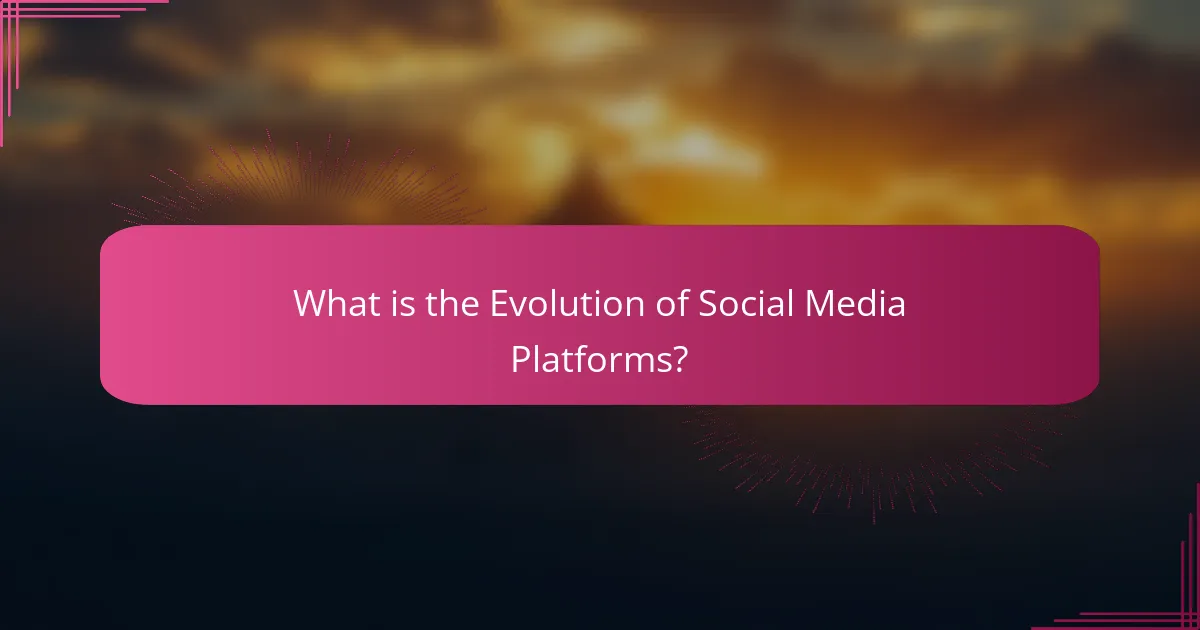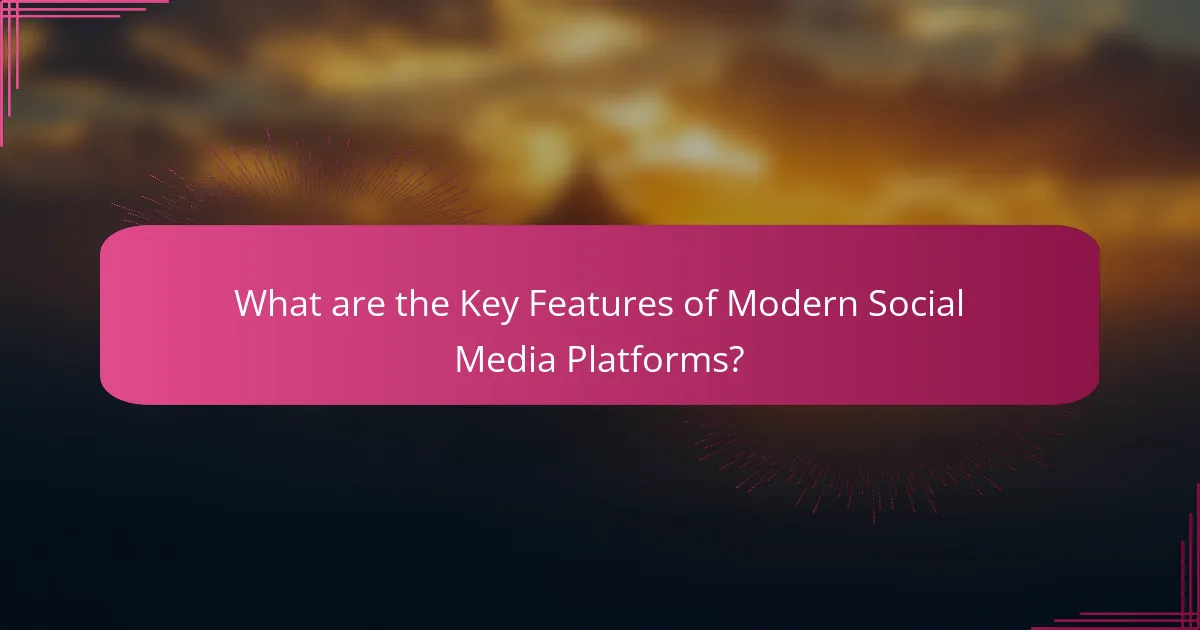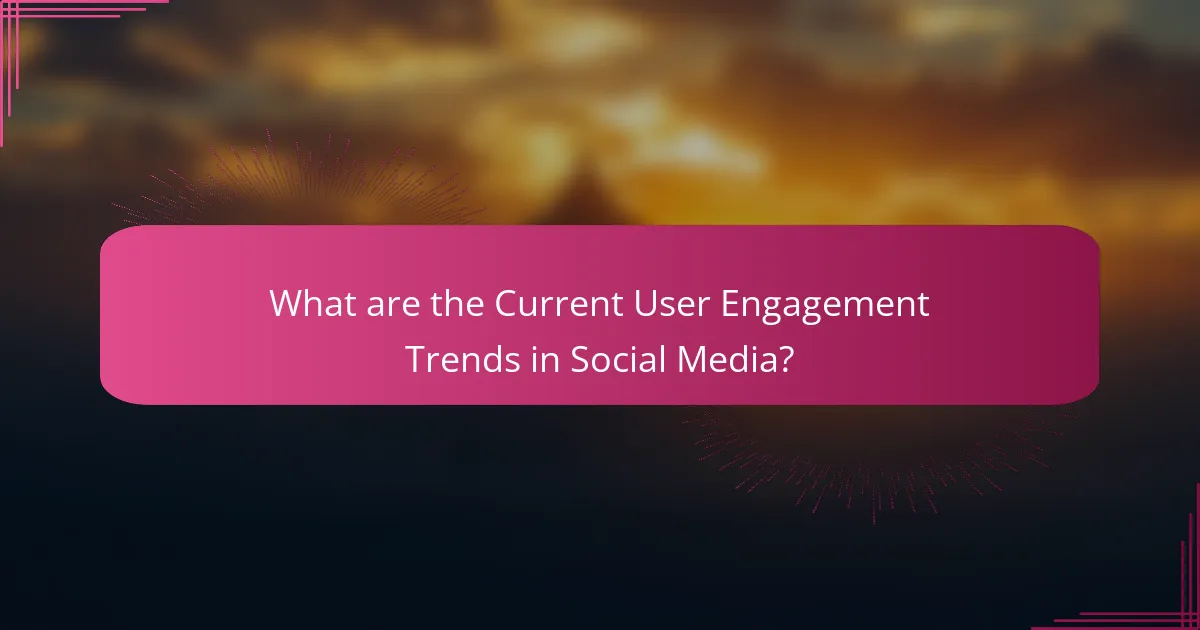The article examines the evolution of social media platforms, highlighting their key features and current user engagement trends. It begins with the launch of Six Degrees in 1997, marking the start of social networking, and traces the development of platforms such as Facebook, Twitter, Instagram, Snapchat, and TikTok. Key features discussed include user-generated content, real-time communication, and algorithm-driven feeds that enhance personalization. The article also addresses trends in user engagement, emphasizing the rise of video content, live streaming, and social commerce, as well as the growing importance of mental health awareness in shaping online interactions.

What is the Evolution of Social Media Platforms?
Social media platforms have evolved significantly since their inception. The first recognizable social media site, Six Degrees, launched in 1997. It allowed users to create profiles and connect with friends. In the early 2000s, platforms like Friendster and MySpace gained popularity. These sites introduced features like user-generated content and customizable profiles. Facebook launched in 2004, revolutionizing social networking with its focus on real identities and connections. Twitter followed in 2006, emphasizing real-time communication through short messages.
The rise of mobile technology in the late 2000s led to the development of apps like Instagram and Snapchat. These platforms prioritized visual content and ephemeral messaging. In the 2010s, TikTok emerged, focusing on short, entertaining videos. Today, social media platforms continue to innovate with features like live streaming and augmented reality. The evolution reflects changing user preferences for connectivity, content sharing, and engagement.
How have social media platforms changed over time?
Social media platforms have evolved significantly since their inception. Initially, they focused on simple text-based communication. Platforms like MySpace and Friendster allowed users to create profiles and connect with friends. Over time, features expanded to include multimedia sharing. Facebook introduced photo and video uploads, enhancing user engagement. The rise of mobile technology further transformed access to social media. Apps like Instagram and Snapchat prioritized visual content and ephemeral posts. Algorithms now dictate content visibility, impacting user interactions. Privacy concerns have led to increased regulations and user awareness. Overall, social media has shifted from basic networking to complex ecosystems of interaction and content sharing.
What were the key milestones in the development of social media?
The key milestones in the development of social media include the launch of Six Degrees in 1997, which allowed users to create profiles and connect with friends. In 2003, LinkedIn was introduced, focusing on professional networking. MySpace followed in 2003, enabling user-generated content and customizable profiles. Facebook launched in 2004, revolutionizing social networking with its user-friendly interface and real-time updates. Twitter emerged in 2006, popularizing microblogging and the use of hashtags. Instagram launched in 2010, emphasizing photo sharing and visual content. TikTok debuted in 2016, introducing short-form video content and rapid viral trends. Each platform contributed significantly to the evolution of social media, shaping user interactions and engagement.
How have user needs influenced these changes?
User needs have significantly influenced changes in social media platforms. Platforms have adapted features to enhance user experience and engagement. For example, the demand for privacy has led to stronger data protection measures. Users increasingly prefer visual content, prompting platforms to prioritize image and video sharing capabilities. The rise of mobile usage has driven the development of mobile-friendly interfaces and applications. Additionally, users seek personalized content, leading to advanced algorithms for tailored feeds. Social media platforms have also integrated messaging features to meet the need for real-time communication. These adaptations reflect a direct response to evolving user preferences and behaviors.
Why is understanding the evolution of social media important?
Understanding the evolution of social media is important because it informs current trends and user behaviors. Social media platforms have transformed significantly since their inception. Historical changes reveal how user engagement has shifted over time. For instance, Facebook’s introduction of the News Feed in 2006 changed content consumption patterns. This feature increased user interaction by 50% within months. Additionally, understanding these changes helps businesses adapt their marketing strategies. Companies can leverage insights from past trends to predict future developments. Thus, awareness of social media’s evolution is crucial for effective communication and engagement strategies today.
What insights can be gained from historical trends?
Historical trends provide valuable insights into the evolution of social media platforms. They reveal patterns in user engagement and feature adoption over time. For example, the rise of mobile usage significantly influenced platform design and functionality. Data shows that platforms like Facebook and Instagram adapted features to enhance mobile user experience. Additionally, historical trends indicate shifts in user demographics and preferences. The introduction of video content on platforms like TikTok has reshaped engagement strategies. Analyzing these trends helps predict future developments and user behaviors. Understanding past successes and failures guides current strategies for social media growth.
How does this knowledge impact future social media strategies?
Understanding the evolution of social media platforms shapes future strategies significantly. This knowledge helps marketers identify key features that enhance user engagement. For instance, platforms like Instagram and TikTok prioritize visual content, which drives higher interaction rates. Research shows that posts with images receive 94% more views than text-only posts. Additionally, recognizing user trends allows brands to tailor their content effectively. Data indicates that 80% of consumers prefer personalized experiences on social media. Therefore, leveraging insights about user preferences can lead to more targeted campaigns. This approach not only increases engagement but also fosters brand loyalty.

What are the Key Features of Modern Social Media Platforms?
Key features of modern social media platforms include user-generated content, real-time communication, and algorithm-driven feeds. User-generated content allows individuals to create and share posts, photos, and videos. Real-time communication facilitates instant messaging and live streaming. Algorithm-driven feeds personalize user experiences by curating content based on preferences. Additionally, social media platforms offer community building through groups and forums. They also provide analytics tools for users to track engagement. Mobile accessibility ensures users can connect anytime and anywhere. Security features protect user data and privacy. These elements contribute to the overall functionality and popularity of social media platforms today.
How do features differ across various social media platforms?
Social media platforms differ in features such as content format, audience targeting, and engagement tools. For instance, Instagram emphasizes visual content through photos and videos. It offers features like Stories and Reels for short, engaging clips. Facebook, on the other hand, supports a wide range of content types, including text, images, and events. It provides tools for group interactions and marketplace functionalities. Twitter focuses on real-time updates with a character limit for posts, encouraging concise communication. LinkedIn is tailored for professional networking, featuring job postings and industry-specific content. TikTok prioritizes short-form video content, utilizing music and effects for creative expression. Each platform’s unique features cater to different user needs and preferences, influencing how users interact and engage.
What are the most common features found in popular platforms?
The most common features found in popular platforms include user profiles, content sharing, and messaging. User profiles allow individuals to create personal accounts and showcase their interests. Content sharing enables users to post text, images, and videos for others to engage with. Messaging features facilitate direct communication between users. Notifications keep users informed about interactions and updates. Search functionalities help users find content and connections easily. Privacy settings allow users to control who sees their information. Analytics tools provide insights into user engagement and content performance. These features enhance user experience and engagement across various platforms.
How do unique features enhance user experience?
Unique features enhance user experience by providing tailored interactions and functionalities. These features cater to specific user needs, improving satisfaction and engagement. For example, personalized content recommendations on platforms like Netflix increase user retention. Additionally, unique features can streamline navigation, making it easier for users to find relevant information. Research shows that 80% of users prefer platforms with customized experiences. Enhanced user experience often leads to increased loyalty and advocacy for the brand. Overall, unique features are pivotal in differentiating platforms and fostering deeper user connections.
Why do certain features drive higher user engagement?
Certain features drive higher user engagement by enhancing user experience and interaction. Engaging features often include personalized content, which caters to individual user preferences. For instance, algorithms that suggest relevant posts keep users interested and active on the platform. Additionally, interactive elements like polls and live videos encourage participation. According to a study by the Pew Research Center, 72% of users prefer platforms that offer interactive content. Features that facilitate community building, such as groups or forums, also promote deeper connections among users. These connections lead to increased time spent on the platform, thus boosting engagement.
What role does user interface play in engagement levels?
User interface significantly impacts engagement levels on social media platforms. A well-designed user interface enhances usability and encourages interaction. Features like intuitive navigation and responsive design keep users engaged longer. Research shows that 94% of first impressions relate to design. Engaging visuals and clear layouts improve user satisfaction. Effective user interfaces can lead to higher retention rates. According to a study by Nielsen Norman Group, users prefer interfaces that are visually appealing. This preference directly correlates with increased engagement metrics.
How do interactive features foster community building?
Interactive features foster community building by facilitating user engagement and communication. These features include comments, likes, shares, and live chats. They allow users to express opinions and connect with others. By participating in discussions, users feel a sense of belonging. This engagement leads to stronger relationships among community members. Research shows that platforms with interactive elements have higher user retention rates. For instance, a study by Pew Research Center found that 70% of users feel more connected to others through these features. Thus, interactive features are essential for nurturing community dynamics.

What are the Current User Engagement Trends in Social Media?
Current user engagement trends in social media include increased video content consumption, particularly short-form videos. Platforms like TikTok and Instagram Reels have seen significant growth in user interactions. Live streaming is also gaining traction, with users favoring real-time engagement. Moreover, personalized content driven by algorithms enhances user retention and satisfaction.
According to a report by Hootsuite, 54% of consumers prefer video content over other formats. Additionally, user-generated content is becoming essential for brands to foster community engagement. Social media stories are increasingly popular, with over 500 million users engaging with Instagram Stories daily.
The rise of social commerce indicates users are more willing to purchase products directly through social media platforms. Finally, mental health awareness has led to users seeking more authentic and positive content online.
How have user engagement strategies evolved recently?
User engagement strategies have evolved to prioritize personalized content and interactive experiences. Social media platforms now use advanced algorithms to tailor content to individual preferences. This shift enhances user satisfaction and encourages longer engagement times. Features like polls, quizzes, and live videos have become prevalent. These interactive elements foster community and real-time participation. Additionally, brands increasingly leverage user-generated content to build authenticity. The emphasis on transparency and trust has grown, aligning with user expectations. Recent statistics show that personalized marketing can increase engagement rates by over 70%. This evolution reflects the changing landscape of user expectations and technological advancements.
What types of content are currently most engaging?
Visual content, particularly videos and images, is currently the most engaging type of content. Research shows that posts with visuals receive 94% more views than those without. Additionally, live videos generate six times more interactions compared to standard video posts. User-generated content also drives engagement, as it fosters community and authenticity. According to a survey by Stackla, 79% of people say user-generated content highly impacts their purchasing decisions. Short-form content, like stories on platforms such as Instagram and Snapchat, captures attention quickly and encourages interaction. Data indicates that 58% of users are more interested in brands that create stories. Overall, content that is visually appealing, authentic, and interactive tends to engage audiences effectively.
How do algorithms influence user interaction?
Algorithms shape user interaction by determining the content users see. They analyze user behavior, preferences, and engagement patterns. This data influences the ranking of posts, advertisements, and recommendations. For example, Facebook’s algorithm prioritizes posts that generate high engagement. This leads to users seeing more of what they interact with frequently. Consequently, user engagement can increase or decrease based on algorithmic changes. Studies show that personalized content can boost interaction rates significantly. For instance, a study by the Pew Research Center found that 64% of users reported that algorithms affect their news consumption. Therefore, algorithms play a crucial role in shaping user experiences on social media platforms.
Why is measuring user engagement crucial for platform success?
Measuring user engagement is crucial for platform success because it directly correlates with user retention and satisfaction. High engagement levels indicate that users find value in the platform. This value drives loyalty and encourages users to return. According to a study by McKinsey, companies that effectively analyze user engagement can improve customer retention rates by 10% to 20%. Additionally, user engagement metrics help platforms refine their features and content. By understanding user behavior, platforms can tailor experiences to meet user needs. Ultimately, this leads to increased revenue and growth opportunities.
What metrics are most indicative of user engagement?
User engagement metrics include likes, shares, comments, and time spent on content. These metrics provide insight into how users interact with posts. Likes indicate approval or enjoyment of content. Shares show that users find the content valuable enough to distribute. Comments reflect deeper engagement and encourage conversations. Time spent on content reveals interest levels and can predict retention. According to a study by HubSpot, posts with higher engagement rates lead to increased visibility in algorithms. This demonstrates that these metrics are crucial for understanding user engagement.
How can platforms adapt based on engagement data?
Platforms can adapt based on engagement data by analyzing user interactions to identify trends. They can modify content algorithms to prioritize popular posts. This ensures users see more of what they engage with. Platforms can also personalize user experiences based on individual engagement patterns. For instance, if users engage more with video content, platforms can promote similar content. Additionally, platforms may refine features like notifications to enhance user retention. By tracking engagement metrics, platforms can identify underperforming features and improve them. Research shows that platforms that adapt quickly to user feedback see increased user satisfaction and retention.
What best practices can enhance user engagement on social media?
To enhance user engagement on social media, brands should create high-quality, relevant content. Engaging visuals, such as images and videos, can significantly boost interaction rates. Regular posting schedules keep audiences informed and engaged. Utilizing interactive elements like polls and quizzes invites user participation. Responding promptly to comments fosters a sense of community. Collaborating with influencers can extend reach and credibility. Analyzing engagement metrics helps refine strategies for better results. According to a Sprout Social report, posts with images receive 650% more engagement than text-only posts.
The main entity of this article is the evolution of social media platforms. It provides a comprehensive overview of the significant milestones in the development of social media, from the launch of Six Degrees in 1997 to the rise of platforms like TikTok and Instagram. The article examines how user needs have influenced platform features and engagement strategies, highlighting key trends such as increased video content consumption and the importance of personalized experiences. Additionally, it discusses current user engagement metrics and best practices for enhancing user interaction on social media platforms.
